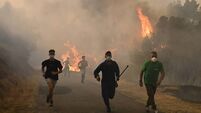UCC president involved in research on role of insects in carbon emissions

Glengarriff Nature Reserve in Co Cork was the Irish location used in the research. Picture: Richard Gordon
Groundbreaking new research involving University College Cork's (UCC) new president has quantified the "amazing" role of insects in the carbon emissions natural cycle.
Prof John O'Halloran, an ecologist and zoologist, was part of an international research team that gauged how much carbon is released from rotting wood worldwide, as well as the role that insects play in the process.
CLIMATE & SUSTAINABILITY HUB












